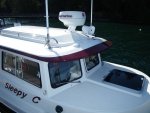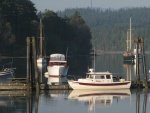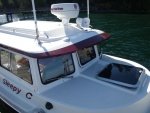BuildItOnce":71pnp52q said:
Harvey,
Interesting thread you've started. Looking forward to hearing replies.
Not only am I new to the c-brat community and c-dory boats, but I'm also new to VHF radio. My other boat is a 16' duroboat that I've owned for around 7 years. I didn't have any sort of radio on the duroboat, so having a VHF on our C-dory is new to me. I've done some reading on the net about using a VHF and general radio etiquette, but I still have a lot more to learn. Would you mind sharing what you use your various radios for? Channels you use? Features you really like having?
We have a basic West Marine VHF580 in our boat and I've wondered what the more advanced radios might give me.
The VHF radio is the primary communication device for a marine vessel in Inland, Coastal or near Coastal waters. It produces a line of sight transmission signal and they generally have 2 power (wattage) settings (1 and 25 or Low and High). The channels have designated uses prescribed by FCC regulation, and there are common channels for various uses sometimes set up by regional practice. Some use channels are:
16 - Emergency, Coast Guard and primary calling channel for establishing connection then moving to another working channel
9 - is also a primary contacting channel though not used as often in my area.
5, 11, 14 - are Vessel traffic (like air traffic control) for commercial boat traffic.
13 - Bridge to Bridge (or captain to captain - not boat to railroad bridge)
22 - Non Emergency use for US Coast Guard
28 - For automated radio checks in some areas
70 - For DSC calling only, then the call is shifted to a second channel of the callers choice
There are lots of others but these are the ones I use in the US. There are some different ones in Canada.
7 - Whale watch service in Canada
11 - Victoria Traffic
71 - Prince Rupert traffic controls Vancouver Island west side and north of Campbell River
82 - For Non emergent contact with Canada Coast Guard
I have on board an active AIS transponder. In crossing the Strait of Juan de Fuca I frequently talk to commercial traffic (anything from the Victoria Clippers - 80 feet and running at 30 knots to 800 or 900 foot ships running at 16 to 25 knots) and when the AIS shows that I will be anywhere with in a mile of those vessels I prefer to confirm their intention to maintain course and speed so that I can adjust mine to get that 1 mile clearance. These arrangements are done via VHF. Most big ships do not monitor 16, and frequently do not have 13 up either so I contact them on the Vessel Traffic channel, and ask to move to 13, where I confirm their intentions.
There are times that I want to know current conditions in an area I am looking to go to or through. If I cannot find a vessel on the AIS, I will call the Vessel Traffic Control and ask if they have someone in that area that I can contact. I try to do that in an unbusy time for them as it is not their job requirement but a courtesy to me. Sometimes I can here them talk to the other vessel, some times they have to relay, and sometimes they will give me the vessel name so I can contact directly.
I have 3 VHF radios on board an all 3 are on always and set at 16, local VTS channel, and depending on where I am, 13 or maybe if I am traveling with someone, it will be on another little used channel so we can talk frequently and freely without bothering anyone. That radio will be set at 1 watt.
I also use on of the radios for a hailer. Mostly I use it in the listen function when entering a marina or coming to a dock. I can hear if someone is trying to tell me I should go to the other side or what ever. All of my radios have hailer/fog function and I use the auto fog horn several times a year.
I would not consider a VHF that does not have an AIS receive function in this day and age. It is so easy to get so much information that can make your life so much more comfortable.
The ICOM M-5-6 has a last call, 2 minute recording feature. I use that radio for monitoring 16 almost exclusively.
There are lots of discussions on this site about VHF use, and there are Utube videos about proper use. (Go to BoatUS.com for starters.)
Just in the last 2 trips I have been on I have seen very significant lack of proper use: Not having the radio on; Having it on and not turned up to be able to hear; Not calling "Securitay" when appropriate; Not responding to a "Securitay" call, even not having a radio on board, or having a working radio.
Personally, that really gets my ire up, because anyone of those MISS actions could cause an accident, property loss, injury or loss of life. Any one of us that can afford a boat, and are smart enough to get it off a trailer should also be smart enough and intelligent enough to learn to use and properly us a VHF. It could save a life, maybe even your own. It should also be part of the boat introduction to visitors or family that are along for the ride. It might be your life they are saving.
[ OK now, I will get down off my high horse. ] I know that there are people out there who want to take their boat and get away from it all, to not be involved and to hide in plain sight. I can appreciate that, but there is also a mariners creed and like the rule here says, "Let's just be nice."
Hope that helps some.
Harvey
SleepyC :moon




